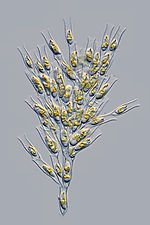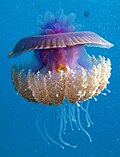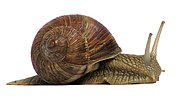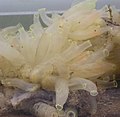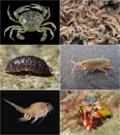The statocyst is a balance sensory receptor present in some aquatic invertebrates, including bivalves, cnidarians, ctenophorans, echinoderms, cephalopods...
5 KB (522 words) - 13:40, 19 April 2024
receptors called statocysts can be found in many invertebrate groups but are not contained in the structure of an inner ear. Mollusk statocysts are of a similar...
26 KB (3,095 words) - 13:24, 30 June 2024
feet report no pressure. However, many malacostracan crustaceans have statocysts, which provide the same sort of information as the balance and motion...
130 KB (12,371 words) - 13:47, 4 July 2024
A few groups have statocysts - fluid-filled chambers containing a small, solid particle or, in a few groups, two. These statocysts are thought to function...
63 KB (6,576 words) - 15:42, 1 June 2024
Sensory organs of gastropods (section Statocysts)
organs of gastropods (snails and slugs) include olfactory organs, eyes, statocysts and mechanoreceptors. Gastropods have no sense of hearing. In terrestrial...
9 KB (719 words) - 17:07, 3 December 2023
to the opposite end). However, since only two of the canals near the statocyst terminate in anal pores, ctenophores have no mirror-symmetry, although...
111 KB (12,379 words) - 02:17, 18 June 2024
Statolith may refer to: A structure in the statocyst, which allows certain invertebrates to sense gravity and balance A structure in the statocyte, cells...
228 bytes (61 words) - 18:42, 24 January 2014
crevices or under objects. Most species, apart from pencil urchins, have statocysts in globular organs called spheridia. These are stalked structures and...
74 KB (7,699 words) - 18:15, 21 June 2024
diverticula. The sensory organs of gastropods include olfactory organs, eyes, statocysts and mechanoreceptors. Gastropods have no hearing. In terrestrial gastropods...
48 KB (5,034 words) - 15:12, 4 July 2024
free-swimming species of Cubozoa and Scyphozoa possess balance-sensing statocysts, and some have simple eyes. Not all cnidarians reproduce sexually, but...
81 KB (8,929 words) - 16:09, 11 July 2024
siliceous cyst that is formed endogenously. Called statospore, stomatocyst or statocyst, this structure is usually globose and contains a single pore. The surface...
16 KB (1,596 words) - 15:34, 29 April 2024
water column to feed by starlight. An internal balancing organ called a statocyst ensures graceful movement. Magister armhook squid prey upon both benthic...
5 KB (510 words) - 04:36, 3 December 2023
Each rhopalium is typically associated with a pair of sensory pits, a statocyst, and sometimes a pigment-cup ocellus. Most species appear to be gonochorists...
10 KB (1,152 words) - 17:56, 27 May 2024
organs of the scaly-foot gastropod include statocysts surrounded by the oesophageal gland, each statocyst with a single statolith. There are also sensory...
63 KB (6,299 words) - 13:29, 9 July 2024
situ hybridization resulted in PaxB expression in the lens, retina, and statocysts. These results and the rejection of the prior hypothesis that Pax6 was...
118 KB (12,370 words) - 16:53, 8 June 2024
can distinguish the polarization of light. Many invertebrates have a statocyst, which is a sensor for acceleration and orientation that works very differently...
90 KB (10,689 words) - 09:43, 4 May 2024
in many marine animals is done with an entirely different organ, the statocyst, which detects the position of tiny calcareous stones to determine which...
17 KB (1,881 words) - 15:47, 21 March 2023
burrowing or feeding) in different classes. The foot carries a pair of statocysts, which act as balance sensors. In gastropods, it secretes mucus as a lubricant...
94 KB (9,545 words) - 23:56, 25 June 2024
and seriates – have statocysts, fluid-filled chambers containing a small solid particle or, in a few groups, two. These statocysts are thought to be balance...
18 KB (1,835 words) - 21:14, 27 December 2023
opposite end from the mouth) is a statocyst, a balance organ that helps it to orient itself. Papillae surround the statocyst. Their function is unclear, but...
10 KB (1,408 words) - 19:43, 5 July 2024
arrangement. Cephalopods have advanced vision, can detect gravity with statocysts, and have a variety of chemical sense organs.: 34 Octopuses use their...
138 KB (15,375 words) - 21:28, 9 July 2024
Mostly these are simple sensory nerve endings, but they also include statocysts and primitive light-sensitive ocelli. Hydroid colonies are usually dioecious...
17 KB (1,865 words) - 15:51, 5 July 2024
a ring comissure of variable complexity. The sensory organs include a statocyst (for balance). Some groups have two unicellular ocelli (simple eyes)....
14 KB (1,357 words) - 22:23, 13 June 2024
which are modified hind wings. Dark cell Migraine-associated vertigo Statocyst List of distinct cell types in the adult human body Boulpaep, Emile L...
27 KB (3,374 words) - 20:38, 6 July 2024
a constant depth. To keep itself upright during swimming, it uses two statocyst gravity-sensing organs that correct it to an upright posture using its...
14 KB (1,708 words) - 01:28, 10 July 2024
extends to form a fin along the tail in the larva. The larva also has a statocyst and a pigmented cup above the mouth, which opens into a pharynx lined...
41 KB (4,900 words) - 02:45, 19 July 2024
frequencies. Oysters perceive near-field sound vibrations by utilizing statocysts. In addition, they have superficial receptors that detect variations in...
100 KB (11,202 words) - 07:16, 16 July 2024
colourful mating displays. Attached to the brain are two organs called statocysts (sac-like structures containing a mineralised mass and sensitive hairs)...
114 KB (11,971 words) - 00:47, 14 July 2024
Sensory organs include compound eyes (often stalked), ocelli (simple eyes), statocysts and sensory bristles. The naupliar eye is a characteristic of the nauplius...
30 KB (2,961 words) - 11:57, 19 July 2024
Aethozooides, Aethozoon, Franzenella and Monobryozoon). The latter having a statocyst‐like organ with a supposed excretory function. The terms Polyzoa and Bryozoa...
135 KB (13,101 words) - 22:53, 30 June 2024









